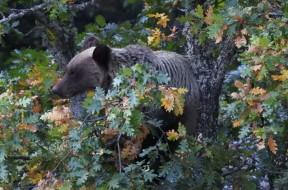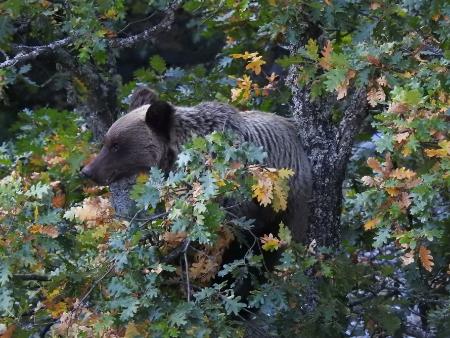Scientists recommend that an overall estimate be made of individuals for the entire Cantabrian Mountain region every five years
A research project conducted by the University of Oviedo, Fundación Oso Pardo (the Brown Bear Foundation), the Spanish National Research Council (IREC-CSIC) and the University of O Porto (CIBIO-InBIO, Portugal) has compared the effectiveness of different genetic tools to estimate the size of brown bear populations, using as a case study the nucleus of brown bears in the Cantabrian Mountains. The project's conclusions, which have been published in the journal Biological Conservation, are that the estimates of population size based on the use of non-invasive genetics (that is, the use of indications left by the animals - such as droppings or hairs) are consistent regardless of the molecular marker used, whether microsatellites or single nucleotide polymorphisms (SNPs) - an issue that has already been discussed within the scientific community. Clarifying this will help to address population estimates with greater certainty
After searching for signs of brown bears in the autumn/winter of 2017 over an area of 3,525 km2 in the eastern part of the Cantabrian Mountains and genetically analysing the samples collected for both molecular markers (microsatellites and SNPs), researchers observed how population-size estimates were consistent, at around 50 bears, regardless of the type of molecular marker used. This study also shows the importance of performing several replications of molecular analyses when genotyping non-invasive samples - not only in the case of microsatellites, as previously known, but also in the use of SNPs. Similarly, for the same number of molecular markers, it is noted that microsatellites still provide more information.
In order to estimate the number of brown bear specimens, the authors of this study recommend a combination of molecular tools on non-invasive samples along with the application of spatially explicit capture-recapture methods, based on how the different individuals detected are distributed, and how often each one is detected within the area.
New approaches to adequate monitoring
As with other European brown bear populations, the population in the Cantabrian Mountains has been increasing in recent decades. For example, in 1989 six females with cubs (cubs of the year) were detected, whereas by 2017 this number had increased to 41 family groups. In this regard, the study confirms the recovery of the species in the eastern part of the Cantabrian Mountains in recent years. The positive trend observed in small populations of large carnivores means that population-monitoring programmes need to be adapted to the way in which the populations are evolving. In the case of the brown bear, the robustness and reliability of indices traditionally used in the Cantabrian Mountains (such as the annual count of the minimum number of bears with young during the year) may be more difficult to maintain over time as the bear population increases in both size and area of distribution.
The aim of this study is to estimate the entire population, not just a fraction of it, and to carry out an annual count of the minimum number of family groups of bears with cubs (as has been done to date). On this, José Vicente López-Bao - who is a researcher at the University of Oviedo associated with the Joint Research Unit on Biodiversity at the Mieres Campus - says "considering that the average generation period for brown bears in the Cantabrian Mountains has been estimated at about nine years and that the Habitats Directive requires member states to carry out periodic monitoring to assess the status of the populations within its borders and report this to Europe every six years, we consider it appropriate to draw up an overall estimate for the whole of the Cantabrian Mountains every five years".
Photos: © Fundación Oso Pardo (Brown Bear Foundation).
Article details
López-Bao, J. V., Godinho, R., Rocha, R. G., Palomero, G., Blanco, J. C., Ballesteros, F., & Jiménez, J. 2020. "Consistent bear population DNA-based estimates regardless molecular markers type". Biological Conservation 248: 108651.




